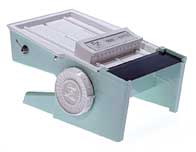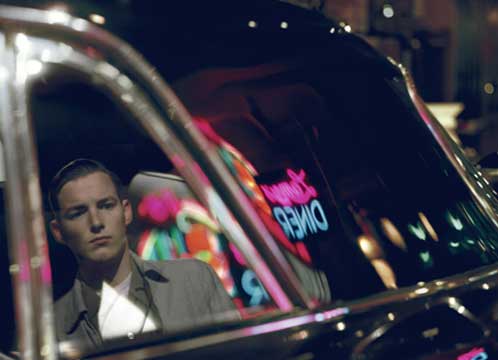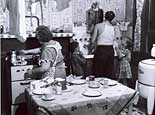 |
||
|
Pittsburgh, circa 1958
|
1958
A playful new exhibition at The Warhol explores the cultural trends and myths of this pivotal year in the U.S. Baby Boom—and how, through their seductive power, those bygone sensibilities continue to shape our world. Hand-motorized kitchen gadgets, at their kitschy height, housed in glass cases. A small console television perched on a white pedestal. Belligerently optimistic marketing slogans, such as “Isn’t that amazing!” and “Wait, there’s more!” pasted in pastel across gallery walls. The theme of The Andy Warhol Museum’s current exhibition, 1958, is obvious asvisitors peruse the eclectic and eccentric memorabilia that date back to the days when a new brand of consumerism washed over a postwar America hungry for all things shiny and new.  But perhaps the heart of the exhibition lies elsewhere, in an episode that took place 16 years later when Chicago subur-banite Eloise Popeil, second wife of Samuel J. Popeil—the original pitchman of the over-hyped schlock now on display at The Warhol, such as the Veg-o-Matic and the portable, foldable Pocket Fisherman—hired a professional hit man to have her husband killed. And just a little more than 11 months later, after Eloise got out of prison, Popeil remarried her. But perhaps the heart of the exhibition lies elsewhere, in an episode that took place 16 years later when Chicago subur-banite Eloise Popeil, second wife of Samuel J. Popeil—the original pitchman of the over-hyped schlock now on display at The Warhol, such as the Veg-o-Matic and the portable, foldable Pocket Fisherman—hired a professional hit man to have her husband killed. And just a little more than 11 months later, after Eloise got out of prison, Popeil remarried her.  In museum director Tom Sokolowski’s version of the story, it was Samuel who originally hired the hit man to execute Eloise. But true to the workings of a successful market economy, she outbid his offer. In retrospect, the exact details of their quarrel may be immaterial, argues Sokolowski, who curated the show. It’s the undercurrent that resounds: “It’s the scandal of their bitter divorce and bizarre reconciliation that exists in between the lines of the story of the time,” he says. “It’s what I call the ‘now of then.’ What do we choose to remember? How do we remember it? What were the feelings of America then?” In museum director Tom Sokolowski’s version of the story, it was Samuel who originally hired the hit man to execute Eloise. But true to the workings of a successful market economy, she outbid his offer. In retrospect, the exact details of their quarrel may be immaterial, argues Sokolowski, who curated the show. It’s the undercurrent that resounds: “It’s the scandal of their bitter divorce and bizarre reconciliation that exists in between the lines of the story of the time,” he says. “It’s what I call the ‘now of then.’ What do we choose to remember? How do we remember it? What were the feelings of America then?” 1958, which is on view at The Warhol through January 11, 2009, marks the tension between the history of this period as it’s officially documented and the way that period, by various turns, is popularly understood. It accomplishes this by examining the cultural myths of the 1950s—myths that are just as relevant today as when they were first conceived, according to Sokolowski. “In light of the current credit crisis and the breakdown of the financial world, maybe Popeil’s divorce is the lesser of the scandals to which he has contributed,” he notes. After all, both American Express and Visa were launched in 1958. It’s interesting to look at the origins of where we are right now, in the context of what it meant back then.” Sokolowski organized the exhibition in three parts: a retrospective of product marketing and development in the burgeoning era of television; a stunning portfolio of staged photographs depicting 1950’s-era American teenagers by artist duo McDermott and McGough, known for their anachronistic flair; and original prints by Andy Warhol that speak to his fascination with both consumer culture and the cultural capital gained by entry into the middle class. Warhol’s simple pencil sketches of shoes and handbags draw upon the proliferation of a new marketing lexicon; his addition of a serpent, skulking innocuously along the fringes, critiques the aesthetic vocabulary he appropriated. “Warhol learned from geniuses of the advertising world,” says Sokolowski, “and he was constantly taken with the idea that we were—and the truth is that we still are—able to be so easily seduced.” Bringing the “A” GameSokolowski originally conceived the show as part of Pittsburgh’s celebration of its 250th anniversary, since 1958 marks the last year the city threw a big bash to honor itself. While he may have been only 8 years old at the time, in Pittsburgh the ‘50s still exist as the recent past for many residents. This is a city rhetorically rooted in the past; streets are often described by landmarks that no longer exist (“take a left at the corner where the old church used to be”), and Pittsburghers still vividly remember the city’s heyday of economic prosperity, albeit ruefully.  McDermott & McGough, Girlie Magazine (detail), 2007While the Popeil Brothers began peddling their goods not in Pittsburgh but on the boardwalks of Asbury Park, New Jersey, their commercial enterprise marked a trajectory from boom to bust that resonated in Pittsburgh as well as throughout the United States. On the boardwalk, tourists and locals were drawn to Samuel, who, unlike his contemporaries, reversed the relationship between product design and marketing in a way that tapped into the consumer psyche like never before tried or accomplished. For the first time, the advertising drove the design. And it worked. For example, no one needed a handy device for making toasted pocket sandwiches over a kitchen stovetop before the Popeils created it. But once they did, suburban housewives bought them. How about a bionic knife that could cut through a nail and also slice a tomato paper thin? Or a Mince-O-Matic—a mincer, chopper, grater, blender, juicer, and food mill all in one? “More than half the products are about food,” says Sokolowski. “Now look at us: Today Americans are fat, we have diabetes, and we’re broke! You have to ask yourself, at what price did we achieve that postwar glory?” The Popeils created gadgets that weren’t just novel or useful (after all, the Whip-O-Matic is still considered more powerful than many electric mixers on the market). Their goods were also attractive, such as classic hand-painted plastic kitchenware made affordable because of the cheap, durable material. “This was a first: pretty nice design that anyone could buy,” says Sokolowski. “That’s yet another way in which the Popeils connected with middle class consumers.” If Samuel convinced American consumers that his wares would make life more palatable, then his son, Ron—proprietor of Ronco & Popeil and the company’s shift to television advertising—convinced them that his wares would make life less boring. The TV products were decidedly different in that they promoted leisure activities, such as Mr. Microphone (grandfather of the karaoke machine) and a Speed-Tufting Kit (making decorative rugs had never been simpler). But the true national pastime became the spending of money itself, notes Sokolowski. “In that sense, 1958 wasn’t so very different than 2008. But we’re now seeing the burst of that bubble.” Reading Between the LinesIn McDermott and McGough’s series of highly stylized photographs, Detroit, the notion of leisure gets caught in between images of upper class teens in Detroit circa 1958, both lingering and loitering in dime stores and diners, on barstools and in bedrooms. The photographs were shot in the enclaves of the Henry Ford Museum in Dearborn, Michigan, spaces Sokolowski likens to scenes that house the full spectrum of historical fictions born of the era. “These are nostalgic images of teenage innocence,” only upon first glance, he says. “But, again, the idleness of the rich, the sexual tensions, the social repression comes through between the lines.” The Ford Museum contains artifacts from legendary moments in American history: Rosa Parks’ bus seat, the limousine in which President Kennedy was assassinated. It’s a befitting locale for the work of David McDermott and Peter McGough, American-born collaborators who first entered the New York art scene in the 1980s. Since then, the duo has eschewed the contemporary to focus on the past by often wearing the clothing from the period of study and employing antiquated photographic techniques. For this series, the duo used an old-school, tri-color carbro process, which produces three separate negatives for yellow, magenta, and cyan to produce brilliant colors and a near cinematic effect. Their young characters are caught in moments of vulnerability amid the hard, metallic lines of their rigid aesthetic and luminescent palette. Under the sheen, only their bemused expressions (parted lips, lowered eyelids) yield to the conflicting ideas of 1950s social pressures. In one photograph, two boys lounge in a bedroom full of youthful clutter—comics, sneakers, sweaters—and, though nothing about their postures overtly suggest sexual intent, the intimacy of the lighting and softness of their postures tell more than the pair even understand themselves. “It’s all very lush,” says Sokolowski. “Sexuality laced with innocence.”  McDermott & McGough, Reflecting, 2007The display of the Popeil family’s goods manages to depict the chasm between the limitless potential of a cash-infused middle class and the birth of an era of spending beyond our means while also identifying the impetus for the societal unrest that followed. Tucked away behind the vivid colors, exclamation points, and serene faces of Detroit are the buried and unaddressed desires of a society that thought it was being satiated through the emerging act of buying objects and experiences—and, in the end, wasn’t fulfilled after all. Pittsburgh’s birth 250 years ago coincided with the beginning of the so-called Enlightenment, says Sokolowski. “Is it fair to say we’ve been on one curve moving up consistently? Or would we say that there have been some steps backward, glitches like the year 1958? And where has it all taken us? Ultimately, we have to ask: Are we better off now with our Veg-O-Matics and Cuisinarts? And, who is to say?” |
|
Darwin’s Big Bang: 150 Years Later · Paging Doctor Darwin · The Horse · Director's Note · NewsWorthy · Now Showing · Face Time: Eric C. Shiner · Artistic License: Inside a Fantastical Mind · About Town: A Wild Weather Adventure · Science & Nature: All Hail the Telescope · First Person: Experiencing Life on Mars, Together · Another Look: Andy Warhol's Time Capsules
 |
Copyright © 2017 CARNEGIE Magazine. All rights reserved. |

